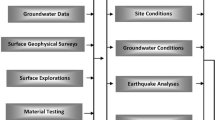Abstract
The decision tree models based on pavement experts’ experiences are usually used to derive pavement maintenance decisions. Because experiences are very difficult to obtain completely, some importance condition attributes in decision tree model are easily to be lost. With the prevailing of the computer, Case Base Reasoning (CBR) or Data Mining approach are used to process a large number of historical pavement maintenance records. But, the shortcoming is all condition attributes have to be included in the analyses.Rough Set Theory was proposed in 1982. Rough Set Theory can reduce the condition attributes and decision rules without changing the accuracy. The provincial and county roads located in north Taiwan are used as the empirical study. With the same accuracy, Rough Set Theory can reduce thirteen condition attributes to eight. Thus, RST is suitable for pavement maintenance decisions.
Preview
Unable to display preview. Download preview PDF.
Similar content being viewed by others
References
Prechaverakul, S., Hadipriono, F.C.: Using a Knowledge-based Expert System and Fuzzy Logic for Minor Rehabilitation Projects in Ohio. Transportation Research Record 1497, 19–26 (1995)
Hajek, J.J., Chong, G.J., Phang, W.A., Haas, R.: ROSE, A Knowledge Based Expert System for Routing and Sealing. In: 2nd North American Conference on Managing Pavement (1987)
Medsker, L.: Design and Development of Expert Systems and Neural networks. Macmillan College Publishing, USA (1994)
Pawlak, Z.: Rough Set. International Journal of Computer and Information Science 11(5), 341–356 (1982)
Pawlak, Z.: Rough Sets: Theoretical Aspects of Reasoning about Data. Kluwer Academic Publisher, Dordrecht (1991)
Attoh-Okine, N.O.: A Rough Set Application to Data Mining Principles in Pavement Management Database. ASCE Journal of Computing in Civil Engineering 11(4), 231–237 (1997)
Attoh-Okine, N.O.: Combining Use of Rough Set Theory and Artificial Neural Networks in Doweled Performance Modeling: A Hybrid Approach. ASCE Journal of Transportation Engineering 128(3), 270–275 (2002)
Author information
Authors and Affiliations
Editor information
Editors and Affiliations
Rights and permissions
Copyright information
© 2009 Springer-Verlag Berlin Heidelberg
About this paper
Cite this paper
Hung, CT., Chang, JR., Lin, JD., Tzeng, GH. (2009). Rough Set Theory in Pavement Maintenance Decision. In: Huang, DS., Jo, KH., Lee, HH., Kang, HJ., Bevilacqua, V. (eds) Emerging Intelligent Computing Technology and Applications. With Aspects of Artificial Intelligence. ICIC 2009. Lecture Notes in Computer Science(), vol 5755. Springer, Berlin, Heidelberg. https://doi.org/10.1007/978-3-642-04020-7_29
Download citation
DOI: https://doi.org/10.1007/978-3-642-04020-7_29
Publisher Name: Springer, Berlin, Heidelberg
Print ISBN: 978-3-642-04019-1
Online ISBN: 978-3-642-04020-7
eBook Packages: Computer ScienceComputer Science (R0)




